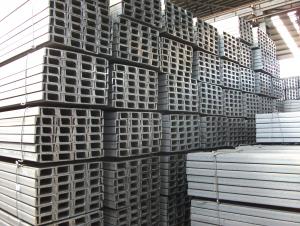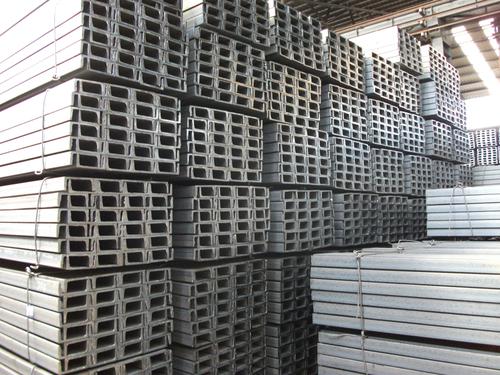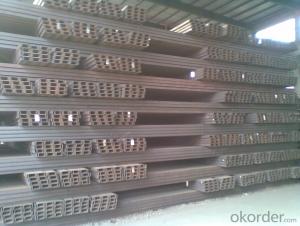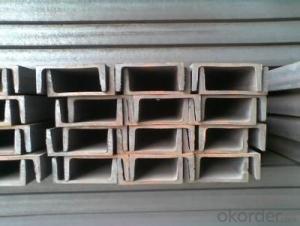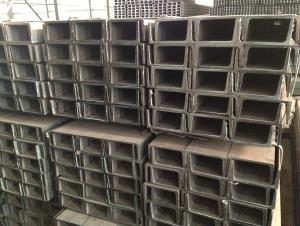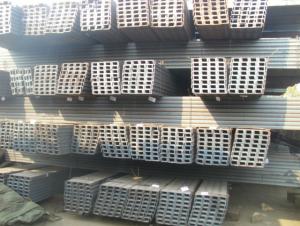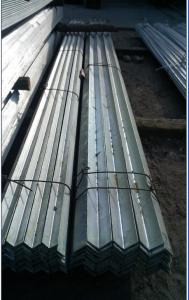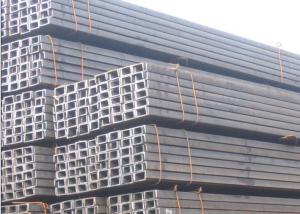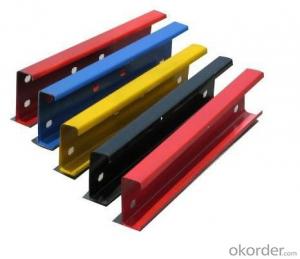GB Q235 Steel Channel
- Loading Port:
- China Main Port
- Payment Terms:
- TT OR LC
- Min Order Qty:
- -
- Supply Capability:
- -
OKorder Service Pledge
OKorder Financial Service
You Might Also Like
Product Description:
Specifications of MS Channel:
1.We supply high quality MS Channel at reasonable price, including Chinese standard, Japanese standard and so on.
Standard | GB |
Material Grade | Q235 |
Technique: | Hot Rolled |
Sizes as per chinese standard: | 50*37*4.5mm - 300*89*11.5mm
|
Sizes as per japanese standard: | 50*25*3mm – 200*80*7.5mm |
Length: | 6meter, 9meter, 12meter |
Note: 1.we are also competent to provide our customers other MS Channel based on other sizes according to customer’s requirements.
2. The length of our ms channel could be cut into other meters as per customer’s requirements. For example, the channel in 6meters could be cut into 5.8meters in order to be fit in the 20ft container.
2. The detailed sections of MS Channel as per GB standard.are shown in the table-1:
GB U CHANNEL | Standard | Sectional | Dimension |
| Mass: |
| (mm) | (mm) | (mm) | (mm) |
|
50X37 | 50 | 37 | 4.50 | 7.0 | 5.438 |
63X40 | 63 | 40 | 4.80 | 7.5 | 6.634 |
80x43 | 80 | 43 | 5.00 | 8.0 | 8.045 |
|
|
|
|
|
|
100x48 | 100 | 48 | 5.30 | 8.5 | 10.007 |
120x53 | 120 | 53 | 5.50 | 9.0 | 12.059 |
140x58 | 140 | 58 | 6.00 | 9.5 | 14.535 |
140x60 | 140 | 60 | 8.00 | 9.5 | 16.733 |
|
|
|
|
|
|
160x63 | 160 | 63 | 6.50 | 10.0 | 17.240 |
160x65 | 160 | 65 | 8.50 | 10.0 | 19.752 |
|
|
|
|
|
|
180x68 | 180 | 68 | 7.00 | 10.5 | 20.174 |
180x70 | 180 | 70 | 9.00 | 10.5 | 23.000 |
|
|
|
|
|
|
200x73 | 200 | 73 | 7.00 | 11.0 | 22.637 |
200x75 | 200 | 75 | 9.00 | 11.0 | 25.777 |
|
|
|
|
|
|
220x77 | 220 | 77 | 7.00 | 11.5 | 24.999 |
220x79 | 220 | 79 | 9.00 | 11.5 | 28.453 |
|
|
|
|
|
|
250x78 | 250 | 78 | 7.00 | 12.0 | 27.410 |
250x80 | 250 | 80 | 9.00 | 12.0 | 31.335 |
250x82 | 250 | 82 | 11.00 | 12.0 | 35.260 |
|
|
|
|
| |
280x82 | 280 | 82 | 7.50 | 12.5 | 31.427 |
280x84 | 280 | 84 | 9.50 | 12.5 | 35.823 |
280x86 | 280 | 86 | 11.50 | 12.5 | 40.219 |
|
|
|
|
|
|
300x85 | 300 | 85 | 7.50 | 13.5 | 34.463 |
300x87 | 300 | 87 | 9.50 | 13.5 | 39.173 |
300x89 | 300 | 89 | 11.50 | 13.5 | 43.883 |
Table-1
3. The chemical composition of HR Channel Steel according to Q235B is shown in Table-2.
Alloy No | Grade | Element(%) | ||||
C | Mn | S | P | Si | ||
Q235 | B | 0.12-0.20 | 0.3-0.7 | ≦0.045 | ≦0.045 | ≦0.3 |
Table-2
Note: we are able to present our customers relevant SGS test report for chemical composition of HR Channel Steel.
Applications of MS Channel:
The MS Channel can be applied to construction of warehouses, workshops, sport stadiums and car parks etc.The hot rolled channel steel belongs to carbon structural steel which is applied to in the field of construction and machinery.In details, the hot rolled channel steel is usually used for arch-itechtural structure, and they could be welded in order to support or hang a vari-ety of facilities. They are also usually used in combination with I beam. Generally,the hot rolled channel steel we supply must possess perfect welding property, riveting property and mechanical property and so on.
Package & Delivery of MS Channel:
1.The hot rolled channel steel will be packed in bundle with steel wire at each end of every bundle and color marking in order to help the customer to recognize his goods more easily at sight.
2. And the hot rolled channel steel could be loaded into 20ft or 40ft container, or by bulk cargo.If the weight of each bundle reaches more than 3.5 mt, the loading by break bulk cargo should be choosed.When the weight of each bundle reaches less than 3mt, the loading by container should be choosed.
3.As for the transportaion from mill to loading port, the truck will be usually used. And the maximum quantity for each truck is 40mt.
4.All in all, we could do in accordance with customer's request.
- Q: What are the different types of supports used for steel channels?
- There are several different types of supports used for steel channels, including wall brackets, floor mounts, ceiling mounts, and beam clamps. These supports are used to secure and stabilize the steel channels in various applications, such as in construction, infrastructure, and industrial settings.
- Q: Can steel channels be used for machinery support?
- Absolutely! Machinery support can indeed be achieved using steel channels. Thanks to their robustness and long-lasting nature, steel channels find frequent utilization in construction and engineering scenarios. They excel as reliable support systems for heavy-duty machinery, offering steadfastness and guaranteeing the equipment's secure functionality. The resilience of steel channels enables them to endure substantial loads, while their customizable design allows for tailoring to precise weight specifications. Furthermore, the straightforward fabrication and installation processes make steel channels a highly feasible option for machinery support.
- Q: What are the tolerance limits for steel channels?
- The tolerance limits for steel channels depend on various factors such as the manufacturing process, the specific type of steel channel, and the industry standards. Generally, tolerance limits refer to the acceptable deviation from the specified dimensions or properties of the steel channels. In terms of dimensions, tolerance limits may include tolerances for width, height, and thickness of the channel. These limits ensure that the channels meet the required specifications and can be used effectively in various applications. For example, the tolerance limits for the width of a steel channel might be ±0.005 inches, meaning the actual width of the channel can vary within this range. Additionally, tolerance limits may also apply to other properties of steel channels such as straightness, squareness, and surface finish. Straightness tolerance ensures that the channel is not bent or warped beyond acceptable limits. Squareness tolerance ensures that the corners of the channel are at right angles to each other. Surface finish tolerance refers to the smoothness and quality of the channel's surface. It is important to note that different industries and applications may have specific tolerance requirements. For instance, channels used in structural engineering and construction may have different tolerance limits compared to channels used in manufacturing or fabrication processes. To determine the exact tolerance limits for steel channels, it is necessary to refer to industry standards and specifications such as those provided by organizations like the American Society for Testing and Materials (ASTM) or the International Organization for Standardization (ISO). These standards outline the acceptable tolerance limits for various dimensions and properties of steel channels, ensuring consistency and quality in their production and use.
- Q: How do steel channels perform in extreme weather conditions?
- Steel channels typically perform well in extreme weather conditions. Due to their strength and durability, they can withstand high winds, heavy rain, and even snow loads. Additionally, steel channels are resistant to corrosion, making them suitable for use in coastal areas or places with high humidity. Overall, their robustness and weather resistance make steel channels a reliable choice for various construction and infrastructure projects.
- Q: Can steel channels be used for automotive applications?
- Yes, steel channels can be used for automotive applications. Steel channels are commonly used in the automotive industry for various purposes such as structural support, frame reinforcements, and chassis components. The high strength and durability of steel make it suitable for withstanding the rigorous demands of automotive applications, providing necessary stability and safety.
- Q: What are the maximum span lengths for steel channels?
- The maximum span lengths of steel channels are influenced by several factors, including the channel's size, shape, material grade, applied load, and desired deflection criteria. Typically, steel channels can have span lengths ranging from a few feet to several hundred feet. For smaller steel channels, like C-shaped or U-shaped channels, the maximum span lengths usually fall between 6 and 20 feet. These channels are commonly used in light structural applications, framing, or as support members in construction projects. On the other hand, larger steel channels used in heavy-duty industrial applications or as primary structural members can accommodate much longer span lengths. These channels are engineered to withstand heavier loads and longer spans. Consequently, the maximum span lengths can reach several hundred feet or even more, depending on the specific design requirements and engineering calculations. It is worth noting that determining the maximum span lengths for steel channels should always be performed by a qualified structural engineer or designer who considers all relevant factors and conducts necessary calculations. This is vital to ensure the safety and structural integrity of the channel system, allowing it to effectively support the intended loads without excessive deflection or failure.
- Q: What material does hot-dip galvanized channel belong to?
- It is basically determined that carbon steel is the raw material of channel steel and carbon steel or low alloy steel billet with carbon content of not more than 0.25%.
- Q: Are there any specific safety considerations when working with steel channels?
- Yes, there are specific safety considerations when working with steel channels. Some of these considerations include: 1. Personal protective equipment (PPE): It is essential to wear appropriate PPE when working with steel channels, such as safety goggles, gloves, steel-toed boots, and a hard hat. This helps protect against potential hazards such as flying debris, sharp edges, and falling objects. 2. Handling and lifting: Steel channels can be heavy and cumbersome, so it is important to use proper lifting techniques and equipment to prevent strain or injury. This may include using lifting straps, slings, or cranes to safely lift and move the channels. 3. Sharp edges and corners: Steel channels often have sharp edges and corners that can cause cuts or punctures. It is important to handle them with care and use appropriate tools, such as gloves, to avoid direct contact with these sharp areas. 4. Structural stability: When working with steel channels in construction or fabrication, it is crucial to ensure the structural stability of the setup. This includes properly securing the channels in place, using appropriate support systems, and following engineering specifications to prevent collapse or accidents. 5. Fire hazards: Steel channels are highly conductive and can quickly transfer heat, making them a potential fire hazard. It is important to take precautions to prevent sparks or open flames from coming into contact with the channels, especially in environments where flammable materials are present. 6. Slips, trips, and falls: Working with steel channels can involve working at heights or on elevated surfaces. It is important to maintain good housekeeping practices, such as keeping work areas clean and clear of obstructions, using proper ladder or scaffolding systems, and using fall protection equipment when necessary to prevent slips, trips, and falls. By considering these safety precautions and following best practices, the risk of accidents and injuries can be greatly reduced when working with steel channels.
- Q: Are steel channels suitable for the mining parts manufacturing industry?
- The mining parts manufacturing industry finds steel channels to be a suitable choice. Steel channels are frequently utilized in various industries, mining included, thanks to their strength, durability, and versatility. They offer structural support and stability, making them perfect for manufacturing robust and reliable mining parts. In the mining industry, heavy-duty equipment, machinery, and components must endure harsh conditions and extreme forces. Therefore, steel channels, with their excellent load-bearing capacity and impact resistance, are well-suited for producing mining parts like support beams, frames, and brackets. Furthermore, steel channels can be fabricated to meet specific dimensional requirements, allowing manufacturers to create customized parts tailored to the unique needs of the mining industry. They can be easily cut, welded, and shaped into intricate forms, enabling the production of complex mining components. Moreover, steel channels possess corrosion resistance, a vital trait in mining environments that often involve exposure to moisture, chemicals, and abrasive materials. This corrosion resistance prolongs the lifespan of mining parts, reducing the need for frequent replacements or repairs and ultimately enhancing operational efficiency while reducing costs. Additionally, steel channels are readily available and cost-effective for the mining parts manufacturing industry. The widespread use of steel channels also means that there is abundant expertise and knowledge in working with this material, allowing for efficient production processes and reliable quality control. In conclusion, steel channels are highly suitable for the mining parts manufacturing industry due to their strength, durability, versatility, corrosion resistance, and cost-effectiveness. These qualities make steel channels an ideal choice for producing mining parts that can withstand the demanding conditions and requirements of the mining industry.
- Q: Can steel channels be used for supporting HVAC systems?
- Yes, steel channels can be used for supporting HVAC systems. Steel channels are typically made of durable and strong steel material, making them suitable for providing structural support to HVAC equipment. They are often used in conjunction with other support materials, such as brackets and hangers, to securely hold and suspend HVAC units, ductwork, and piping. Steel channels offer several advantages for supporting HVAC systems. Firstly, they have high load-bearing capacity, ensuring that the weight of the HVAC equipment and components is adequately supported. Additionally, steel channels are resistant to corrosion and can withstand harsh environmental conditions, making them suitable for both indoor and outdoor applications. Steel channels also provide flexibility in terms of installation. They can be easily adjusted and customized to accommodate different HVAC system configurations. Moreover, steel channels can be installed using various methods, such as welding, bolting, or clamping, offering versatility in the installation process. It is important to ensure that the steel channels used for supporting HVAC systems are designed and installed according to industry standards and local building codes. Proper engineering and design considerations, including load calculations, seismic requirements, and thermal expansion, should be taken into account to ensure the safety and stability of the HVAC system. Overall, steel channels are a reliable and commonly used method for supporting HVAC systems, providing strength, durability, and flexibility in installation.
Send your message to us
GB Q235 Steel Channel
- Loading Port:
- China Main Port
- Payment Terms:
- TT OR LC
- Min Order Qty:
- -
- Supply Capability:
- -
OKorder Service Pledge
OKorder Financial Service
Similar products
Hot products
Hot Searches
Related keywords
